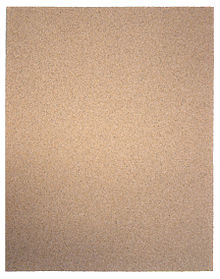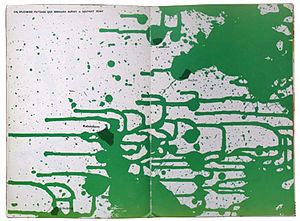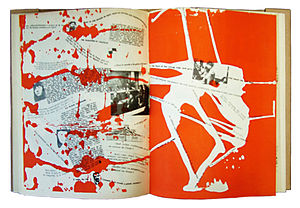- Mémoires
-
- For other uses, see Memoir (disambiguation).
 The sandpaper cover of Mémoires
The sandpaper cover of Mémoires
Mémoires (Memories) is an artist's book made by the Danish artist Asger Jorn in collaboration with the French artist and theorist Guy Debord. Printed in 1959, it is the second of two collaborative books by the two men whilst they were both members of the Situationist International.
Contents
Psychogeography and détournement
The book is a work of psychogeography, detailing a period in Debord's life when he was in the process of leaving the Lettrists, setting up Lettrism International, and showing his 'first masterpiece',[1] Hurlements en Faveur de Sade (Howling In Favour Of Sade), a film devoid of imagery that played white when people were talking on the soundtrack and black during the lengthy silences between.
Credited to Guy-Ernest Debord, with structures portantes ('load-bearing structures') by Asger Jorn, the book contains 64 pages divided into three sections. The first section is called 'June 1952', and starts with a quote from Marx:
Let the dead bury the dead, and mourn them.... our fate will be to become the first living people to enter the new life.
The second section, 'December 1952', quotes Huizinga, and the third, 'September 1953', quotes Soubise.
The work contains two separate layers. The first is printed with black ink, reproducing found text and graphics taken from newspapers and magazines. The second layer is printed using coloured inks, splashed across the pages. These sometimes connect images and text, sometimes cover them, and sometimes are seemingly unconnected. The black layer contains fragments of text, maps of Paris and London, illustrations of siege warfare, cheap reproductions of old masters and questions such as 'How do you feel about the world at the moment, Sir?' The coloured layer contains freefloating ink splashes, lines created by a matchstick loaded in ink, and a Rorschach inkblob.
Other pages deal with more personal themes, including a cartoon of the first showing of his film Hurlements en Faveur de Sade, with comments for and against, and references to Dérive, which would become known as Situationist Drift, the habit of walking aimlessly through a city in an attempt to find its spirit. Détournement ('diversion' or 'disruption') is also employed in the book to disorient the reader by creating startling collaged juxtapositions. Originally deriving from Dada,[2] détournement would become a key situationist strategy.
The last page is an orange swirl, above which reads the single sentence 'I wanted to speak the beautiful language of my century.'[3]
Auto-destruction: the sandpaper cover
The book is most famous for its cover, a dust jacket made of heavy-grade sandpaper. Usually credited to Debord, the sleeve was actually conceived in a conversation between Jorn and the printer, V.O. Permild:
[Permild:] Long had [Jorn] asked me, if I couldn’t find an unconventional material for the book cover. Preferably some sticky asphalt or perhaps glass wool. Kiddingly, he wanted, that by looking at people, you should be able to tell whether or not they had had the book in their hands. He acquiesced by my final suggestion: sandpaper (flint) nr. 2: ‘Fine. Can you imagine the result when the book lies on a blank polished mahogany table, or when it's inserted or taken out of the bookshelf. It planes shavings off the neighbour's desert goat.[4]
Fin de Copenhague
 'A splendid landscape that Bernard Buffet often painted': a page spread in Fin de Copenhague
'A splendid landscape that Bernard Buffet often painted': a page spread in Fin de Copenhague
Fin de Copenhague (Goodbye to Copenhagen) is the first collaboration between the two artists. The artists' book is credited to Asger Jorn, with Debord listed as "Technical Adviser in Détournement". Also printed by Permild and Rosengreen, Copenhagen, the book was published by Jorn's Edition Bauhus Imaginiste in May 1957, a few months before this group amalgamated with the Lettrist International to create the Situationists.
In many ways very similar to the later book, the colour layers are more exuberant, the text more pointed. One page, for instance, asks in English:
What do you want? Better and cheaper food? Lots of new clothes? A dream home with all the latest comforts and labour saving devices? A new car . . . a motor launch . . . a light aircraft of your own? Whatever you want, it's coming your way - plus greater leisure for enjoying it all. With electronics, automation and nuclear energy, we are entering on the new Industrial Revolution which will supply our every need, easily . . . quickly . . . cheaply . . . abundantly.[5]
Other pages include text in French, German, and Danish; illustrations of whisky bottles beer bottles and cigarettes; aeroplanes and ocean going liners; cartoons of well dressed men and pretty girls and various maps of copenhagen. One page declares, 'There's No Whiteness....Viva Free Algeria!' Each page is then covered with a second layer of coloured ink drops and drips, most of which go right to left, emphasising the direction of the book from beginning to end.
The book ends with the text:
Hurry! Hurry! Hurry! Tell us in not more than 250 words why your girl is the sweetest girl in town.[6]
Methods of production
Having just arrived in Copenhagen, Jorn and Debord rushed into a newsagents, stole a huge amount of magazines and newspapers, and spent a drunken afternoon collaging elements together. The next day they arrived at the printers with 32 collages, which were transferred to lithographic plates. Jorn then sat at the top of a ladder over the zinc plates, dropping cup after cup of Indian ink onto them. The plates were then etched and printed over the black texts and images.
The cover was a heavily embossed image of an advertisement for a razor blade.
The spectacle
The situationist concept of the spectacle runs through both books; represented by the newspapers and magazine collage elements, the collage and ink (détournement) used to disrupt the text represents a strategy to see the city as it really is, rather than as charted in maps and signposts.
'The spectacle epitomises the prevailing model of social life. It is the omnipresent celebration of a choice already made in the sphere of production, and the consummate result of that choice. In form as in content the spectacle serves as total justification for the conditions and aims of the existing system.' Guy Debord[7]
Editions
Originally printed in an edition of 200 by Edition Bauhus Imaginiste in Copenhagen, Fin de Copenhague was reprinted by Editions Allia in 2001 [2]. Mémoires was also printed in Copenhagen, in 1959, by Éditions Situationist International. It has been reprinted by Jean-Jacques Pauvert aux Belles Lettres in 1993.
Notes
- ^ Asger Jorn, The Crucial Years 1954-64, Atkins, Lund Humphries, p 57
- ^ Guy Debord, Merrifield, Reaktion, 2005, p 25
- ^ 'Je voulais parler la belle langue de mon siècle', Mémoires, p62
- ^ Memories on Asger Jorn, Troels Andersen, quoted in Books Of Warfare, The Collaboration between Guy Debord & Asger Jorn from 1957-1959, Christian Nolle [1]
- ^ Fin de Copenhague, Asger Jorn, Editions Allia, 2001
- ^ 'The replies, together with the girl's photograph and her address written on the back, were to be sent to the Psychogeographical Committee Of London (especially Debord and Jorn.) ....Nothing is known about the replies Jorn received...' Taken from Art in Progress-Asger Jorn, Atkins, Methuen 1964, inside cover
- ^ Society of the Spectacle, Thesis 6
References
- Mémoires, Guy Debord and Asger Jorn, Editions Situation International, 1959
- Asger Jorn, Guy Atkins, Methuen, 1964
- Asger Jorn, The Crucial Years 1954-64, Guy Atkins, Lund Humphries, 1977
- Guy Debord, Merrifield, Reaktion, 2005
- Potlatch 1954-57, Debord and others, Lebovici, 1985
- Panegyric, Debord, Verso, 1991
- Fin de Copenhague, Asger Jorn and Guy Debord, Editions Allia, 2001
- Books of Warfare: The Collaboration between Guy Debord & Asger Jorn from 1957–1959, Christian Nolle, [3]
Early precursors Expressionism and Cubism Futurism, Vorticism and Dada Zang Tumb Tumb · Tango With Cows · BLAST · BÏF§ZF+18 · Universal War · Jedermann sein eigner Fussball · An Anna Blume · Russian BalletConstructivism, Surrealism
and ModernismLettrism, Situationism,
Nouveau réalisme
and Arte PoveraYves Peintures · Fin de Copenhague · Mémoires · Zone de Sensibilité Picturale Immatérielle · Linee · DimanchePop Art Fluxus and Conceptual art Literaturwurst · Topographie Anécdotée du Hasard · Water Yam · Grapefruit · Fluxus 1 · Un Coup de Dés Jamais N'Abolira Le HasardArtists' books since 1980 Categories:- Artist's books and multiples
- French art
- Danish art
- Situationist writings
- 1959 books
Wikimedia Foundation. 2010.

